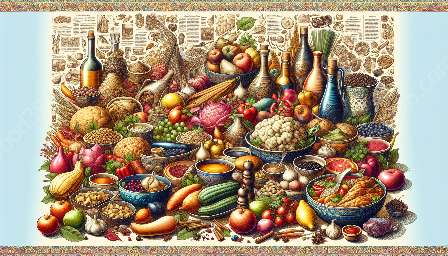Fresh water sources play a crucial role in the development of irrigation systems and the cultivation of specific crops, influencing the food culture and its geographical origin and evolution.
1. The Influence of Fresh Water Sources on Irrigation Systems
Fresh water sources, such as rivers, lakes, and groundwater, have historically shaped the development of irrigation systems. The availability of freshwater for agricultural purposes has enabled civilizations to establish complex irrigation networks, such as canals, aqueducts, and water diversion techniques, to ensure the consistent supply of water to crops.
For example, in ancient Mesopotamia, the Tigris and Euphrates rivers facilitated the development of extensive irrigation systems, allowing for the cultivation of crops such as wheat, barley, and dates. Similarly, the Nile River played a pivotal role in the advancement of irrigation techniques in ancient Egypt, leading to the cultivation of crops like papyrus, barley, and flax.
2. Cultivation of Specific Crops
The availability of fresh water sources directly impacts the types of crops that can be cultivated in a region. Crops with high water requirements, such as rice, sugarcane, and certain fruits and vegetables, thrive in areas with abundant freshwater resources, where irrigation can sustain their growth.
In contrast, arid regions with limited access to fresh water may predominantly cultivate drought-resistant crops, such as millet, sorghum, and cacti. The cultivation of specific crops is deeply intertwined with the availability of freshwater, as it determines the agricultural practices and food staples of a particular region.
3. Influence on Food Culture
The development of irrigation systems and the cultivation of specific crops have a profound impact on food culture. The availability of fresh water sources allows for the cultivation of diverse crops, leading to the creation of distinct culinary traditions and dietary preferences.
For instance, regions with abundant water sources may specialize in rice cultivation, giving rise to culinary traditions that center around rice-based dishes and cooking techniques. In contrast, arid regions may prioritize the cultivation of drought-resistant grains and legumes, shaping their food culture around hearty stews and bread made from alternative flours.
4. Influence of Geography on Food Culture and Its Evolution
Geography plays a pivotal role in shaping food culture, as it determines the types of crops that can be grown and the availability of fresh water sources for irrigation. The geographical features of a region, such as its climate, soil composition, and proximity to water bodies, significantly influence the culinary practices and food choices of its inhabitants.
Over time, the availability of fresh water sources and the cultivation of specific crops have contributed to the evolution of food culture. As civilizations developed advanced irrigation systems and agricultural techniques, new crops were introduced, traded, and integrated into local cuisines, enriching the food culture with diverse flavors and ingredients.
Conclusion
The availability of fresh water sources is intricately linked to the development of irrigation systems, the cultivation of specific crops, and the evolution of food culture. Understanding the influence of geography on food culture enables us to appreciate the rich tapestry of cuisines that have emerged from the harmonious interplay between freshwater resources, agricultural practices, and culinary traditions.


